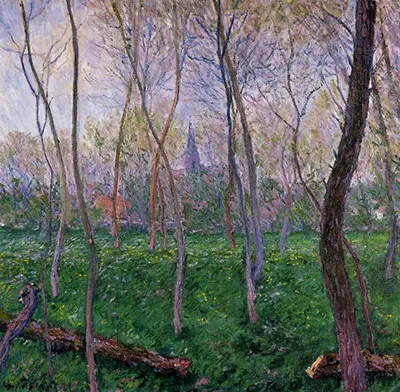He again showcases his agility in the use of bold colours on a simple subject - his wife Camille who is sitting near River Seine, gazing at Bennecourt suburb. The still waters at the river show a reflection of the inn where Claude was staying with his family.
At the time, young Monet, his wife and son were staying at a nearby inn, which was located near Bonnieres-sur-Seine village. He was struggling financially as he barely cashed in on his work. In fact, Claude and his family left the inn a few weeks after their stay as he couldn’t pay for it.
Unknown to Monet, this piece would later become a masterpiece of his unique Impressionism style.
Today, it is one of the earliest hallmarks of the style, showcasing Monet's unique painting style - the use of an open-air setting, vibrating brushstrokes to highlight the fading light, a simple subject and the high-keyed palette of greens, yellows and blues. The painting also shows a rowboat in the forefront, which they would roar to and from the inn.
Being the founder of Impressionism, Claude Monet was the most influential landscape painters in the history of art. A Paris native, Monet joined in Glenyre studio where he met Bazille, Renoir and Sisley, the pioneers of the Impressionist group. It was then that Monet acquainted himself with painting the outdoors and broke off the convention of painting still objects.
He developed his characteristic style of incorporating the fleeting effects of the weather, season, time of the day and atmosphere using bold colours and light.
Monet removed dull colours like black and grey and banked on more natural alternatives to bring out a series of the same view using different light and weather conditions. He also introduced the study of the transitory effects of natural light on paintings, making him the forerunner of the 20th-century modernism.
Monet was just fifteen when he ventured into art. At the time, however, he only drew caricatures in charcoal, an undertaking that had made him a name in Paris.
It was then that he interacted with Eugene Boudin who urged him to explore Impressionism painting by showcasing the different effects of light. Claude later understood what Eugene had been telling him and went on to paint his first Impressionist painting.
Garden at Sainte-Addresse - Created in 1867, the painting features sunlit scenery at a seaside resort close to Le Havre. Claude and his family spent that summer at Sainte-Adresse. It was here that he painted the piece by adopting an elevated point of view.
The painting emphasises the use of bold colours that are highlighted by the terrace, sky and sea and the white hade that brings out the flat surface on the canvas. His father is shown seated as several of Monet’s relatives are enlisted as models. Monet displayed the piece in 1879, twelve years after its creation during the fourth Impressionist exhibition where he named it Jardin a Sainte Adresse.
The Green Wave - This seascape only debuted during the 1879 Impressionist exhibition. A critic viewing the painting at the time observed the piece was inspired by Manet.
He stated that Monet’s composition and handling of paint, especially where the horizon line is drawn way up, reverberates Manet's depictions of American warships, like The Battle of Kearsarge, the Alabama and the Kearsarge at Boulogne (at the Philadelphia Museum of Art). The paintings were showcased in Paris during the 1865 and 1867 exhibitions.


